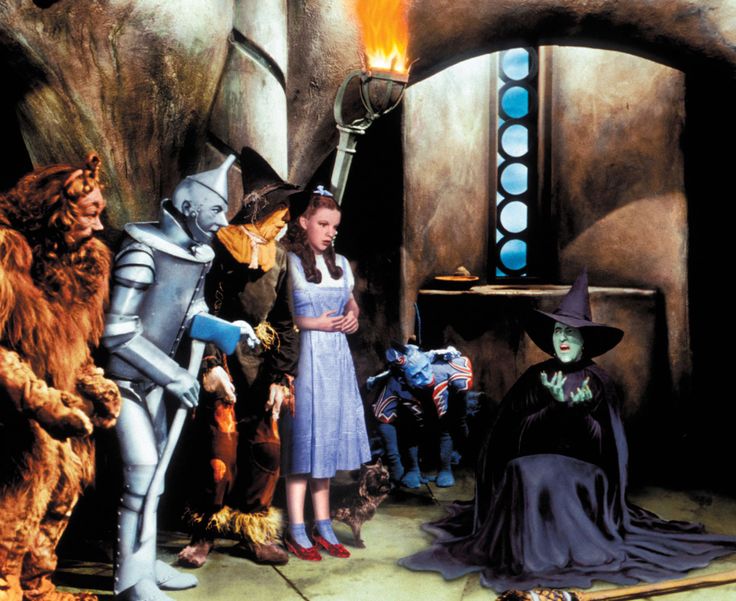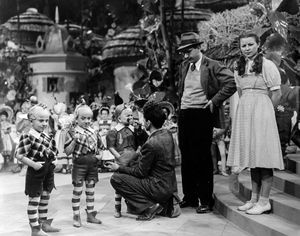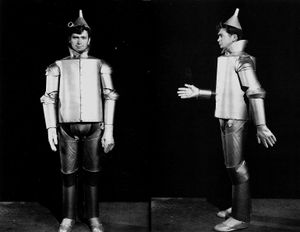The Wizard of Oz (partially found deleted scenes of musical fantasy film; 1938-1939): Difference between revisions
No edit summary |
JustinHoskie (talk | contribs) No edit summary |
||
| Line 8: | Line 8: | ||
Although it remains the most famous and successful adaptation of L. Frank Baum's ''The Wonderful Wizard of Oz'' to this day, production was a bit of a nightmare. With a total of five directors, '''a plethora of footage''' was shot that was either scrapped or cut out of the film after preview showings. | Although it remains the most famous and successful adaptation of L. Frank Baum's ''The Wonderful Wizard of Oz'' to this day, production was a bit of a nightmare. With a total of five directors, '''a plethora of footage''' was shot that was either scrapped or cut out of the film after preview showings. | ||
==Norman Taurog - Summer 1938== | ==The First Directors (Production Begins)== | ||
===Norman Taurog - Summer 1938=== | |||
[[File:Untitled.jpg|thumb|300px|Bobby Koshay (Garland's stand-in) and who appears to be Norman Taurog on the Munchkinland set between test-shots.]] | [[File:Untitled.jpg|thumb|300px|Bobby Koshay (Garland's stand-in) and who appears to be Norman Taurog on the Munchkinland set between test-shots.]] | ||
In July 1938, MGM announced that they had tapped director Norman Taurog, who had a reputation of guiding young performers, to helm their upcoming film adaptation of ''The Wonderful Wizard of Oz''. Working on the film during the extensive wardrobe and makeup tests for the summer of 1938, Taurog was paid for three-days of directorial work for the project, most likely for test shots performed in July-August. During the first week of September, however, Taurog was replaced by Richard Thorpe and reassigned to ''The Adventures of Huckleberry Finn'', which would be released on February 10, 1939. | |||
In July 1938, MGM announced that they had tapped director Norman Taurog, who had a reputation of guiding young performers, to helm their upcoming film adaptation of ''The Wonderful Wizard of Oz''. Working on the film during the extensive wardrobe and makeup tests for the summer of 1938, Taurog was paid for three-days of directorial work for the project, most likely for test shots performed in July-August. During the first week of September, however, Taurog was reassigned to ''The Adventures of Huckleberry Finn'', which would be released on | |||
Though some pictures from the set have survived, the test footage shot by Taurog is presumed lost. | Though some pictures from the set have survived, the test footage shot by Taurog is presumed lost. | ||
==Richard Thorpe - Fall 1938== | ===Richard Thorpe - Fall 1938=== | ||
After Taurog | After Taurog's reassignment, MGM brought in director Richard Thorpe to work on the film. According to the book ''The Wizard of Oz: The Official 50th Anniversary Pictorial History'', Thorpe "had a reputation for bringing in pictures on budget and on schedule, which must have been a real attraction as the studio watched preproduction costs mount on ''The Wizard of Oz''." | ||
On October 13, filming began on the MGM Studios lot, and continued for a total of nine days. The scenes filmed included Dorothy and the Scarecrow's first encounter in the cornfield and various sequences in the Wicked Witch's castle. After an on-set mishap caused the production to shut down, producer Mervyn LeRoy reviewed Thorpe's footage and decided that it lacked the childlike wonder and innocence the production needed, and that Thorpe was rushing the production. Thorpe was subsequently fired | On October 13, filming began on the MGM Studios lot, and continued for a total of nine days. The scenes filmed included Dorothy and the Scarecrow's first encounter in the cornfield and various sequences in the Wicked Witch's castle. After an on-set mishap caused the production to shut down, producer Mervyn LeRoy reviewed Thorpe's footage and decided that it lacked the childlike wonder and innocence the production needed, and that Thorpe was rushing the production. Thorpe was subsequently fired. | ||
As a new director was sought out and hired, director George Cukor took over while waiting for his next film, ''Gone With the Wind'', to begin filming. Staying with the film for less for a week, he was brought on to help shape the film. | |||
==='''The Original Dorothy'''=== | All footage from Thorpe's reign was scrapped, and like the Taurog footage, is presumed to be lost. Two notable aspects of the Thorpe footage include... | ||
[[File:98cdd0b51cc3efe8011843e7b2b469b6-1-.jpg|thumb|300px|Hamilton (left) and Garland (right) in their original makeup, used under Thorpe.]] | |||
===='''The Original Dorothy'''==== | |||
Under Thorpe's reign as director, the makeup and costume designs for Dorothy, the Scarecrow, and the Wicked Witch differed from what they would be in the final film. Though subsequent changes to the Witch's and the Scarecrow would be fairly minor, Dorothy proved to be another story. | Under Thorpe's reign as director, the makeup and costume designs for Dorothy, the Scarecrow, and the Wicked Witch differed from what they would be in the final film. Though subsequent changes to the Witch's and the Scarecrow would be fairly minor, Dorothy proved to be another story. | ||
| Line 29: | Line 30: | ||
After Thorpe was taken off the production, Cukor had her makeup and wardrobe altered, and gave her a more naturalistic look. He also told Garland to play Dorothy more down-to-earth, to remember that she was "just a little girl from Kansas." | After Thorpe was taken off the production, Cukor had her makeup and wardrobe altered, and gave her a more naturalistic look. He also told Garland to play Dorothy more down-to-earth, to remember that she was "just a little girl from Kansas." | ||
[[File:Buddy_tin_man.jpg|thumb|300px|Buddy Ebsen in a costume test.]] | |||
===='''The Original Tin-Man'''==== | |||
Originally cast as the Tin-Man was MGM contract player Ray Bolger. However, knowing that the movements of the Scarecrow would be closer to the type of dancing he had become known for and specialized in -- Having been inspired to become a dancer after seeing a production of ''The Red Mill'' staring Fred Stone, who originated the role of the Scarecrow in the 1902 ''The Wizard of Oz'' stage production. -- and feeling he was more suited for the role, he requested to switch roles with Buddy Ebsen, who had been cast as the Scarecrow. The studio approved, and the roles were switched. | |||
After working on pre-recording and costume / makeup tests between September 22 and October 17, Ebsen began filming scenes five days into shooting. on October 17th, involving the film's climax inside of The Witch's Castle. Three days later, on October 21, he suffered an allergic reaction to the aluminum dust used in his makeup. | |||
Ebsen later recalled: '''''"They put aluminum dust all over my makeup, and this aluminum dust got into the air, and pretty soon my lungs were coated with it. One night I took a breath and nothing happened. They got an ambulance for me and rushed me down to the hospital."''''' | |||
The production was shut down as a replacement was sought out, who would go onto be 20th Century Fox contract player Jack Haley, and Thorpe was replaced. Haley, who was not told the reason for Ebsen's departure and whose makeup was quietly replaced with aluminum paste instead of powder, would later re-recorded all of Ebsen's solo song moments in the film, though Ebsen's voice remains in the film during the group vocals on "We're Off to See the Wizard." | |||
Ebsen wouldn't return to MGM until December 13, to begin work on the film ''Four Girls in White.'' | |||
[[Category:Lost films]] | [[Category:Lost films]] | ||
Revision as of 18:49, 5 August 2015
Regarded as the most viewed film in history, The Wizard of Oz needs no introduction. It is a 1939 American musical fantasy film produced by Metro-Goldwyn-Mayer (MGM), directed by Victor Fleming and (an uncredited) King Vidor. Produced by Mervyn LeRoy, the film stars Judy Garland, Frank Morgan, Ray Bolger, Bert Lahr, Jack Haley, Billie Burke, and Margaret Hamilton, and was written by Noel Langley, Florence Ryerson, and Edgar Allan Woolf with songs by Harold Arlen and E. Y. "Yip" Harburg.
Although it remains the most famous and successful adaptation of L. Frank Baum's The Wonderful Wizard of Oz to this day, production was a bit of a nightmare. With a total of five directors, a plethora of footage was shot that was either scrapped or cut out of the film after preview showings.
The First Directors (Production Begins)
Norman Taurog - Summer 1938
In July 1938, MGM announced that they had tapped director Norman Taurog, who had a reputation of guiding young performers, to helm their upcoming film adaptation of The Wonderful Wizard of Oz. Working on the film during the extensive wardrobe and makeup tests for the summer of 1938, Taurog was paid for three-days of directorial work for the project, most likely for test shots performed in July-August. During the first week of September, however, Taurog was replaced by Richard Thorpe and reassigned to The Adventures of Huckleberry Finn, which would be released on February 10, 1939.
Though some pictures from the set have survived, the test footage shot by Taurog is presumed lost.
Richard Thorpe - Fall 1938
After Taurog's reassignment, MGM brought in director Richard Thorpe to work on the film. According to the book The Wizard of Oz: The Official 50th Anniversary Pictorial History, Thorpe "had a reputation for bringing in pictures on budget and on schedule, which must have been a real attraction as the studio watched preproduction costs mount on The Wizard of Oz."
On October 13, filming began on the MGM Studios lot, and continued for a total of nine days. The scenes filmed included Dorothy and the Scarecrow's first encounter in the cornfield and various sequences in the Wicked Witch's castle. After an on-set mishap caused the production to shut down, producer Mervyn LeRoy reviewed Thorpe's footage and decided that it lacked the childlike wonder and innocence the production needed, and that Thorpe was rushing the production. Thorpe was subsequently fired.
As a new director was sought out and hired, director George Cukor took over while waiting for his next film, Gone With the Wind, to begin filming. Staying with the film for less for a week, he was brought on to help shape the film.
All footage from Thorpe's reign was scrapped, and like the Taurog footage, is presumed to be lost. Two notable aspects of the Thorpe footage include...
The Original Dorothy
Under Thorpe's reign as director, the makeup and costume designs for Dorothy, the Scarecrow, and the Wicked Witch differed from what they would be in the final film. Though subsequent changes to the Witch's and the Scarecrow would be fairly minor, Dorothy proved to be another story.
Under studio direction, Garland wore a long, blonde wig, heavy, "baby-doll" makeup, and a blue cotton pinafore with a blue poka-dot border, and directed to be played in an exaggerated fashion.
After Thorpe was taken off the production, Cukor had her makeup and wardrobe altered, and gave her a more naturalistic look. He also told Garland to play Dorothy more down-to-earth, to remember that she was "just a little girl from Kansas."
The Original Tin-Man
Originally cast as the Tin-Man was MGM contract player Ray Bolger. However, knowing that the movements of the Scarecrow would be closer to the type of dancing he had become known for and specialized in -- Having been inspired to become a dancer after seeing a production of The Red Mill staring Fred Stone, who originated the role of the Scarecrow in the 1902 The Wizard of Oz stage production. -- and feeling he was more suited for the role, he requested to switch roles with Buddy Ebsen, who had been cast as the Scarecrow. The studio approved, and the roles were switched.
After working on pre-recording and costume / makeup tests between September 22 and October 17, Ebsen began filming scenes five days into shooting. on October 17th, involving the film's climax inside of The Witch's Castle. Three days later, on October 21, he suffered an allergic reaction to the aluminum dust used in his makeup.
Ebsen later recalled: "They put aluminum dust all over my makeup, and this aluminum dust got into the air, and pretty soon my lungs were coated with it. One night I took a breath and nothing happened. They got an ambulance for me and rushed me down to the hospital."
The production was shut down as a replacement was sought out, who would go onto be 20th Century Fox contract player Jack Haley, and Thorpe was replaced. Haley, who was not told the reason for Ebsen's departure and whose makeup was quietly replaced with aluminum paste instead of powder, would later re-recorded all of Ebsen's solo song moments in the film, though Ebsen's voice remains in the film during the group vocals on "We're Off to See the Wizard."
Ebsen wouldn't return to MGM until December 13, to begin work on the film Four Girls in White.



